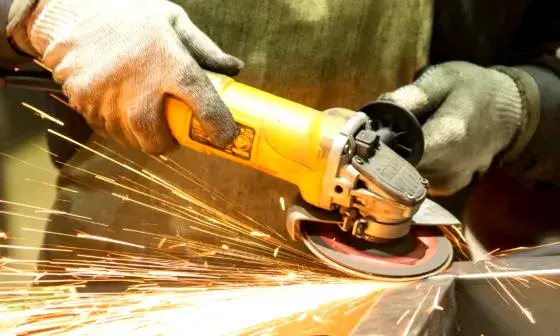An angle grinder is a versatile power tool that can be used for a variety of tasks, such as cutting, grinding, sanding, polishing, and sharpening. Angle grinders are commonly used in metalworking, woodworking, construction, and automotive industries. They can cut through various materials, such as metal, wood, concrete, stone, tile, and brick. However, there are some limitations to what an angle grinder can cut, and using it improperly can result in damage, injury, or fire.
The Limitations of Angle Grinders
The answer to what an angle grinder cannot cut is simple: anything that is too hard, too soft, or too flammable. These materials can either damage the blade, clog the motor, or cause sparks and flames. Let’s look at some examples of these materials and why they are not suitable for angle grinders.
Hard materials: Some materials are too hard for the standard blades of angle grinders, such as diamond, ceramic, glass, and hardened steel. These materials can wear out the blade quickly, reduce its cutting efficiency, or even cause it to shatter. To cut these materials, you need a special blade that is designed for hard materials, such as a diamond blade or a carbide-tipped blade. These blades are more expensive and require more care and maintenance than regular blades.
Soft materials: Some materials are too soft for the standard blades of angle grinders, such as rubber, plastic, foam, fabric, and paper. These materials can melt, burn, or get stuck in the blade, causing it to overheat, jam, or lose balance. To cut these materials, you need a special blade that is designed for soft materials, such as a serrated blade or a fine-toothed blade. These blades are more delicate and prone to breaking than regular blades.
Flammable materials: Some materials are too flammable for the standard blades of angle grinders, such as gasoline, oil, paint, and wood. These materials can ignite from the friction, heat, or sparks generated by the blade, causing a fire or an explosion. To cut these materials, you need to take extra precautions, such as wearing protective gear, working in a well-ventilated area, and keeping a fire extinguisher nearby. You also need to use a blade that is designed for flammable materials, such as a metal-cutting blade or a wood-cutting blade. These blades are less likely to produce sparks than regular blades.
How to Use an Angle Grinder Safely and Effectively
An angle grinder is a powerful tool that can handle a wide range of cutting tasks, but it also comes with some risks and challenges. To use an angle grinder safely and effectively, you need to follow some basic guidelines, such as:
Choose the right blade: As mentioned above, different materials require different blades. You need to choose the blade that matches the material you are cutting, the size and speed of your angle grinder, and the desired finish and quality of your cut. You also need to check the condition of your blade before using it, and replace it if it is dull, cracked, or damaged.
Wear the proper safety equipment: An angle grinder can produce a lot of noise, dust, debris, and sparks, which can harm your eyes, ears, skin, and lungs. You need to wear the proper safety equipment, such as goggles, ear plugs, gloves, and a mask, to protect yourself from these hazards. You also need to wear clothes that are not loose or flammable, and tie up any long hair or jewelry that could get caught in the blade.
Secure the workpiece: An angle grinder can exert a lot of force on the workpiece, which can cause it to move, vibrate, or kick back. You need to secure the workpiece with clamps, vices, or other devices, to prevent it from shifting or slipping while you are cutting. You also need to support the workpiece with a sturdy surface, such as a table or a bench, to prevent it from sagging or breaking.
Hold the angle grinder correctly: An angle grinder can be heavy, bulky, and difficult to control, especially for long periods of time. You need to hold the angle grinder correctly, with both hands, to maintain a firm and comfortable grip. You also need to position the angle grinder at the right angle, usually between 15 and 30 degrees, to the workpiece, to ensure a smooth and accurate cut. You also need to avoid twisting, bending, or tilting the angle grinder, as this can cause the blade to bind, kick back, or shatter.
Follow the manufacturer’s instructions: An angle grinder is a complex and sophisticated tool that has its own specifications and features. You need to follow the manufacturer’s instructions, which are usually provided in the manual or on the label, to operate the angle grinder correctly. You also need to follow the manufacturer’s recommendations for maintenance, storage, and disposal of the angle grinder and its accessories.
Conclusion
An angle grinder is a versatile and useful tool that can cut through various materials, but it also has some limitations and dangers. You need to be aware of what an angle grinder cannot cut, and how to use it safely and effectively, to avoid damage, injury, or fire. By following the guidelines in this article, you can make the most of your angle grinder and achieve the best results for your cutting projects.

